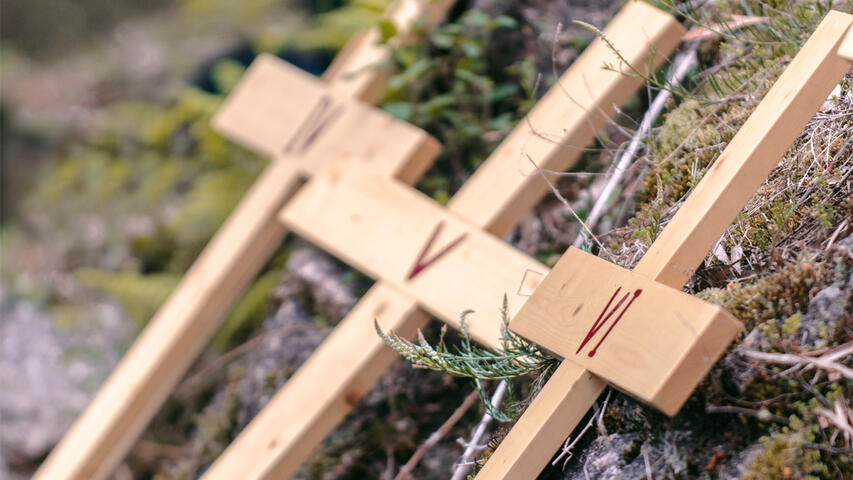Easter festivities
Easter Week in As Rías Baixas
Cangas and Meis are the capitals of this festival in the province of Pontevedra.
If there are two focal points of Holy Week in the province of Pontevedra, they are undoubtedly the municipalities of Cangas and Meis. Both traditions, which are recognised as being of Galician Tourist Interest, are synonymous with solemnity, realism and high spirituality. You will relive the Passion of Christ!
CANGAS
The great participation is one of the hallmarks of the Holy Week of Cangas, in O Morrazo, today consolidated and rooted. The Brotherhood of the Virgen de los Dolores y de la Soledad, the Brotherhood of the Santísimo Cristo del Consuelo and the Brotherhood of the Misericordia have their origins in the 18th century. Throughout the years their rituals have been enriched and have given rise to one of the most colourful and artistic stagings, as well as one of the most secluded. Today this tradition is considered one of the most complete and spectacular in the whole province.
The carvings, which stand out for being articulated and also for their size and decoration, are preceded by the hooded penitents. These figures, practically unique in Galicia, also bear the stamp of the master Cerviño, sculptor of the famous cross of O Hío.
The articulated and beautifully decorated carvings, some of which are the work of the master Cerviño, are carried through the historic centre of Cangas during the Procession of the Holy Meeting.
Good Friday is the big day, as the morning procession known as La Negación de San Pedro (The Denial of St. Peter) takes place on this day. This is followed by the procession of the Holy Encounter, which simulates Christ's Calvary. At this moment, the articulated images of Saint John, the Veronica together with the Three Marías and the Santísima Virgen de los Dolores surprise, in the old area, to meet in the Plaza de la Constitución with the passage of the Nazarene, accompanied by the Cirineo and Roman sayones. In the afternoon the performance of the Descent from the Cross takes place, when the articulated image of Christ is unhinged and placed in a glass urn at the feet of the Virgen de los Dolores. Emotion and realism are added to a scene that continues with the procession of the Holy Burial and the procession of Silence, at midnight. The candles as the only illumination, the drums marking the passage and the brotherhoods distinguish this moment.

MEIS
In Paradela, Meis, another of the best known celebrations in Galicia takes place. Although there is no certainty as to its origin, it is known that it dates back to the 18th century, when a carving of Jesus was acquired. If in the past it was inside the church where the representations took place - by means of an articulated carving with which the unbinding was staged - today these rituals have taken to the streets in a deep-rooted tradition since 1920. Realism is the main feature of this tradition, in which all the biblical passages of the Passion of Christ are represented live and direct.
Nowadays, the Last Supper or the Resurrection on Easter Sunday are some of the moments staged in this unique and peculiar event. Other relevant scenes are the Blessing of Palm Sunday; the representation of the Arrest and Judgement of the Sanhedrin on Maundy Thursday; the staging of the last hours of Jesus' life with the Stations of the Cross; the Desenclavo and Descent of Jesus or the Procession of the Holy Burial on Good Friday, as well as the Blessing of the Water and the Fire.

PONTEVEDRA
The celebration has its origins in the 15th century. Nowadays, attending this liturgy means experiencing unique moments such as the procession with the image of Jesus entering Jerusalem, the procession of the Christ of the Fallen, the procession of Jesus of Nazareth and Mary of Hope, the procession of the Virgin of Solitude and Jesus, the procession of the Steps, the procession of the Meeting with the penitential Way of the Cross, the procession of the Holy Burial or the procession of the Meeting of the Risen Christ with his mother, the Virgin Mary.
VIGO
On Palm Sunday , the procession of La Borriquita takes place; on Maundy Thursday, the procession of La Pasión leaves the church of Sagrado Corazón; in the neighbourhood of Teis the procession of Nuestro Padre Jesús Nazareno y la Virgen de los Dolores is staged; and in Bouzas the procession of the Nazareno and the Virgen Dolorosa de la Reconciliación. On Good Friday, the processions of the Encuentro, the Virgen de la Soledad and the Santo Entierro take to the streets.
BAIONA
On Maundy Thursday there is the procession of the Pasos, with living figures, and on Good Friday the Santo Entierro - or procession of the men - is staged. The procession of the Dolorosa - or women's procession - closes the events in the municipality.
A GUARDA
The mass in coena domini, the preached Eucharist and the procession of the Pasos are celebrated. The Adoration of the Cross takes place on Good Friday, with the procession of the Encounter, the Sermon of the Seven Words and the procession of the Holy Burial. The Solitude of Mary with the Stations of the Cross, the Easter Vigil and the Solemn Mass of Glory close this tradition on Holy Saturday.
